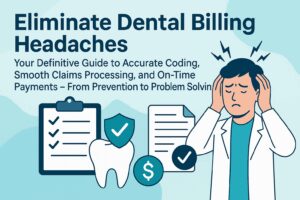
How to Submit Dental Claims Accurately and On Time

Dental claims processing can be a headache for many dental practices. We understand the challenges of navigating insurance paperwork, ensuring accurate coding, and meeting submission deadlines. That’s why we’re here to guide you through the process of submitting dental claims accurately and on time. By mastering these skills, you’ll improve your revenue cycle management and reduce the stress of dental billing.
In this article, we’ll cover essential strategies to streamline your dental insurance claims process. We’ll discuss how to gather comprehensive patient information, master dental coding best practices, and prepare complete supporting documentation. We’ll also explore ways to leverage technology for timely submissions and share tips on verifying insurance coverage. By following these steps, you’ll be well-equipped to handle dental claims processing efficiently and maximize your reimbursements.
Gather Comprehensive Patient Information
To submit dental claims accurately and on time, we need to start by gathering comprehensive patient information. This step is crucial for smooth dental insurance claims processing and effective revenue cycle management. Let’s break down the key components of this process.
Verify insurance details
The first step in gathering patient information is to verify their insurance details. This process is vital to prevent claim denials and ensure timely submission. When a patient calls to make an appointment, we collect their full name, birthdate, address, and all their insurance information. It’s important to double-check this information when the patient arrives for their appointment.
To verify insurance details accurately, we need the following information: • Name of insurance provider • Insurance company address • Member ID number • Member and patient date of birth • Name of employer • Group ID number • Telephone number of insurance (if you don’t have a login for the web portal)
With this information, we can check patient eligibility and obtain a full breakdown of their benefits. It’s crucial to confirm that the patient’s coverage is currently active, what procedures are covered, and the percentage of costs covered for each procedure.
Collect medical history
Collecting a comprehensive medical history is essential for providing the best possible care and avoiding potential complications. We ask patients to complete a detailed health history form that includes information about: • Current health conditions and illnesses • Contact information for primary healthcare providers and specialists • Current medications • Reasons for seeking dental care
It’s important to review this information carefully with the patient before beginning any examination or treatment. This conversation allows us to clarify any questions and gather additional details that may be relevant to their dental care.
Document treatment plans
Once we’ve verified insurance details and collected the patient’s medical history, we can move on to documenting treatment plans. This step is crucial for ensuring that both the patient and the insurance company understand the proposed procedures and associated costs.
When preparing a treatment plan, we: • Calculate insurance benefits and patient portions • Present the plan to the patient for review and acceptance • Offer payment installment options if applicable • Obtain the patient’s signature on the treatment plan
By following these steps, we can gather all the necessary information to submit accurate dental claims and provide excellent patient care. Remember, thorough documentation and verification are key to successful dental billing and timely reimbursement.
Master Dental Coding Best Practices
To submit dental claims accurately and on time, mastering dental coding best practices is crucial. Proper coding ensures that dental insurance claims are processed smoothly and reimbursements are received promptly. Let’s explore some key strategies to improve your dental coding skills.
Use up-to-date CDT codes
The American Dental Association (ADA) updates the Current Dental Terminology (CDT) manual annually. These changes may include deletions, revisions, or additions of dental billing codes. It’s essential to stay current with these updates to ensure accurate coding and increase the potential for reimbursements from dental insurance carriers.
To keep your practice up-to-date:
• Subscribe to dental coding and administration newsletters • Attend regular dental coding workshops and CE courses • Update your dental coding manuals to the latest versions
Remember, most Practice Management Software (PMS) requires manual updates before using the latest codes. Make sure to run these updates promptly to avoid coding errors.
Understand code modifiers
Code modifiers provide additional details about the procedures performed, helping insurance companies understand the specifics of the treatment. These two-digit additions to CPT or HCPCS codes can significantly impact reimbursement.
Common modifiers include:
• 22: Indicates an unusually complicated procedure • 51: Used when multiple surgical procedures are performed during the same operation • 76: Denotes a repeated procedure on the same day
Understanding and correctly applying these modifiers can help prevent claim denials and ensure proper reimbursement for the services provided.
Avoid upcoding and undercoding
Accurate coding is essential for maintaining the integrity of your practice and avoiding potential legal issues. Upcoding occurs when a provider uses a code for a more complex or expensive service than what was actually performed. Conversely, undercoding happens when a lower-level code is used, resulting in reduced reimbursement.
To prevent these issues:
• Always code based on the actual services performed • Train your staff to document procedures accurately • Regularly review your coding practices to ensure compliance
By following these best practices, you can improve your dental claims processing and enhance your revenue cycle management. Remember, accurate coding not only ensures proper reimbursement but also helps maintain a strong relationship with insurance carriers and patients.
At One Dental Billing, we understand the complexities of dental coding and can help streamline your billing process. Our team of experts stays up-to-date with the latest CDT codes and best practices to ensure accurate and timely claim submissions.
Prepare Complete and Accurate Documentation
To ensure timely submission and processing of dental claims, it’s crucial to prepare comprehensive and accurate documentation. This step is vital for effective dental insurance claims processing and revenue cycle management. Let’s explore the key components of proper documentation.
Include necessary X-rays and charts
X-rays play a crucial role in supporting dental claims. Different procedures require specific types of X-rays as attachments. For instance, scaling and root planing claims often need a full mouth series (FMS) and periodontal charting. When submitting claims for crowns or implants, it’s essential to include pre-operative and post-operative X-rays. These visual aids help insurance companies understand the necessity of the procedure and verify its completion.
In addition to X-rays, periodontal charts are vital for certain procedures. For example, when submitting claims for periodontal maintenance (D4910), a current and complete periodontal chart from the date of service may be required to demonstrate that the patient doesn’t have active disease requiring repeat scaling.
Write detailed procedure notes
Detailed procedure notes are essential for accurate dental billing and claims processing. When writing notes, it’s beneficial to follow a structured approach. One effective method is the SOAP format:
• Subjective: Document the patient’s chief concern and related specifics. • Objective: Record the patient’s current health status, exam findings, and diagnostic information. • Assessment: State your diagnosis based on the subjective and objective information. • Plan: Outline the unique treatment plan recommended for the patient.
This approach ensures that all necessary information is included in the patient’s record, supporting the claim’s validity.
Attach supporting narratives
Narratives provide additional context and justification for the procedures performed. They’re particularly useful when X-rays alone may not fully demonstrate the necessity of a treatment. A well-written narrative can significantly impact the outcome of a claim, especially in cases of adverse benefit determinations.
When writing narratives, it’s important to be thorough and specific. For example, when submitting a claim for a crown, your narrative might state: “Initial placement of a crown on [Tooth #] due to large old composite filling that is broken & recurrent decay. <50% natural tooth left. A build-up & crown is necessary to properly restore the tooth.”
At One Dental Billing, we understand the complexities of dental claims documentation. Our team of experts can help you prepare comprehensive and accurate documentation, ensuring smooth dental insurance claims processing and improved revenue cycle management.
Remember, while it may take extra time to prepare detailed documentation, it’s an investment that can significantly enhance your practice’s bottom line and reduce the likelihood of claim denials.
Leverage Technology for Timely Submissions
In today’s fast-paced dental industry, leveraging technology is crucial for timely dental claims submissions and efficient revenue cycle management. By implementing the right tools and software, dental practices can streamline their billing processes, reduce errors, and accelerate reimbursements.
Implement practice management software
Investing in modern practice management software is essential for efficient dental claims processing. These comprehensive systems integrate various aspects of your practice, including patient records, scheduling, and billing. When choosing software, look for options that offer:
• Cloud-based accessibility for real-time updates • Automated claim creation and submission • Built-in coding and billing guidelines • Integration with digital imaging systems
By utilizing advanced practice management software, dental offices can significantly reduce the time spent on administrative tasks and focus more on patient care. This technology also helps minimize errors in claim submissions, leading to faster reimbursements and improved cash flow.
Set up automated claim tracking
Implementing automated claim tracking systems can revolutionize your dental billing process. These tools allow you to monitor the status of submitted claims in real-time, eliminating the need for manual follow-ups and reducing the risk of claims falling through the cracks. Key features to look for in automated claim tracking systems include:
• Real-time eligibility verification • Electronic remittance advice (ERA) processing • Automated denial management • Customizable reporting and analytics
With automated claim tracking, dental practices can quickly identify and address any issues that may delay reimbursement, ensuring a smoother revenue cycle management process.
Consider One Dental Billing’s tech solutions
For dental practices looking to optimize their claims submission process, One Dental Billing offers cutting-edge technology solutions designed specifically for the dental industry. Their comprehensive platform includes:
• Advanced claim submission tools • Real-time eligibility verification • Automated claim tracking and reporting • Integration with popular practice management software
By partnering with One Dental Billing, dental practices can leverage state-of-the-art technology to streamline their billing processes, reduce claim denials, and accelerate reimbursements. Their expertise in dental insurance claims processing can help practices navigate the complex world of dental billing more efficiently.
Embracing technology for timely submissions is no longer optional in the competitive dental industry. By implementing practice management software, setting up automated claim tracking, and considering specialized solutions like those offered by One Dental Billing, dental practices can significantly improve their revenue cycle management and focus more on providing excellent patient care.
Remember, the key to successful dental claims processing lies in combining advanced technology with expert knowledge of dental billing practices. By staying up-to-date with the latest technological advancements and partnering with experienced professionals, dental practices can ensure timely submissions, reduce claim denials, and maintain a healthy financial outlook.
Conclusion
Mastering dental claims submission is crucial for the financial health of any dental practice. By gathering comprehensive patient information, staying up-to-date with coding practices, preparing thorough documentation, and leveraging technology, dental offices can streamline their billing processes and improve their revenue cycle management. These steps help to minimize claim denials and speed up reimbursements, allowing practices to focus more on patient care.
Implementing these strategies may seem daunting, but the long-term benefits are substantial. Dental practices can significantly enhance their operational efficiency and financial stability by adopting these best practices. To further optimize your claims submission process, consider exploring One Dental Billing’s Claims Submission Services. With the right approach and tools, dental practices can navigate the complex world of insurance claims with confidence, ensuring timely payments and a healthier bottom line.
FAQs
What are some key considerations for ensuring a dental claim is processed swiftly?
To expedite the processing of dental insurance claims, it’s crucial to be proactive by anticipating policy-related questions, ensuring all patient information is complete on every claim, assisting the dental consultant in reviewing your claim, and clearly understanding what treatments are covered versus what are necessary.
What steps can I take if I disagree with a dental bill?
If you’re dissatisfied with a dental bill, you can start by contacting your state’s dental regulator or local dental society for guidance. You can also file a complaint with the Better Business Bureau. As a final measure, seeking legal advice might be an option.
What is involved in submitting a dental claim?
Submitting a dental claim involves sending a formal request for payment to your dental insurance provider. This claim details the services and procedures performed by your dentist and their team during your appointment.
How can I attach an Explanation of Benefits (EOB) to a dental claim in Open Dental software?
In Open Dental software, to attach an Explanation of Benefits (EOB) to a dental claim, navigate to the specific claim and double-click on an insurance payment to edit. This action can also be performed by clicking ‘Save’ to finalize a payment in the Edit Insurance Payment window, which will allow you to view or attach EOBs.
Contact Us
Phone: 908-357-1515
111 Town Square Pl, Suite 1203 Jersey City, NJ 07310












